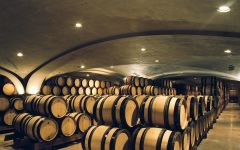Guigal Condrieu 2017
-
James
Suckling -
Jeb
Dunnuck -
Wine
Enthusiast



Product Details
Your Rating
Somm Note
Winemaker Notes
Harmony between a beautiful freshness and a fruit that bathes in a fleshy roundness. A remarkable minerality in this vintage.
Professional Ratings
-
James Suckling
Attractive, fresh apricots and white nectarines. White flowers, too. Very fresh and bright. The smooth and even palate has a very rich and concentrated core of apricots. Super-ripe and super-fresh.
-
Jeb Dunnuck
Leading off with the two Condrieu releases, the 2017 Condrieu offers an exotic, fresh, vibrant style that’s going to gain weight with time in bottle. Terrific notes of pineapple, green citrus, and a hint of minerality all flow to a medium-bodied, balanced beauty that I’d be happy to own in quantity. For a hot, hot vintage, the estate preserved freshness and purity.
-
Wine Enthusiast
Whiffs of sun-kissed grain or hay are restrained on the nose, but the palate of this voluminous Viognier bursts of peach, honeysuckle and apricot. It’s lavish and textured, with a long, warming finish marked by layers of saffron and candle wax. Vintus LLC
Other Vintages
2021-
Wine
Spectator -
James
Suckling -
Jeb
Dunnuck
-
Wine
Spectator -
Jeb
Dunnuck -
James
Suckling -
Robert
Parker
-
Jeb
Dunnuck -
Wine
Enthusiast -
Robert
Parker
-
James
Suckling -
Wine
Spectator -
Wine &
Spirits -
Jeb
Dunnuck -
Robert
Parker
-
Wine
Spectator -
Jeb
Dunnuck -
Wine
Enthusiast -
Robert
Parker
-
Robert
Parker -
James
Suckling -
Wine
Spectator
-
Robert
Parker -
Wine
Spectator
-
Wine
Spectator -
Robert
Parker -
Wine &
Spirits
-
Robert
Parker
-
Wine &
Spirits -
Robert
Parker -
Wine
Spectator
-
Robert
Parker -
Wine
Spectator -
Wine &
Spirits
-
Robert
Parker -
Wine
Spectator
-
Wine &
Spirits -
Wine
Spectator
-
Wine
Spectator -
Robert
Parker
-
Wine &
Spirits
-
Robert
Parker
-
Robert
Parker
-
Robert
Parker
-
Robert
Parker







The Guigal domain was founded in 1946 by Etienne Guigal in the ancient village of Ampuis, home of the wines of the Côte-Rôtie. In these vineyards that are over 2400 years old, you can still see the small terraced walls characteristic of the Roman period. Etienne Guigal arrived in this region in 1923 at the age of 14. He made wine for over 67 vintages and, at the beginning of his career, participated in the development of the Vidal-Fleury establishment.
Despite his young age, Marcel Guigal took over from his father in 1961 when the latter was victim to a brutal illness rendering him blind. Marcel's hard work and perseverance enabled the Guigals to buy out Vidal-Fleury in 1984, although the establishment retains its own identity and commercial autonomy. In 2000, the Guigals purchased the Jean-Louis Grippat estate in Saint-Joseph and Hermitage, as well as the Domaine de Vallouit in Côte-Rôtie, Hermitage, Saint-Joseph and Crozes-Hermitage.
In the cellars of the Guigal estate in Ampuis, the northern appellations of the Rhône Valley are produced and aged. These are the appellations of Côte-Rôtie, Condrieu, Hermitage, Saint-Joseph and Crozes-Hermitage. The great appellations of the Southern Rhône, Chateauneuf-du-Pape, Gigondas, Tavel and Côtes-du-Rhône, are also aged in the Ampuis cellars.

Full-figured and charmingly floral, Viognier is one of the most important white grapes of the northern Rhône where it is used both to produce single varietal wines and as an important blending grape. Look for great New World examples from California, Oregon, Washington and cooler parts of Australia. Somm Secret—Viognier plays a surprisingly important role in the red wines of Côte Rôtie in the northern Rhône. About 5% Viognier is typically co-fermented with the Syrah in order to stabilize the color, and as an added benefit, add a subtle perfume.

As the source of some of the most vibrant and powerful white wines in France, Condrieu is uniquely situated in one of the northern outposts of the Rhone River. It is the original Viognier appellation with a wine growing history reaching back well over two thousand years. Like most of the wine regions of the Northern Rhone, Condrieu’s vines grow on extremely steep and narrow granite terraces. But what makes the region unique is a topsoil, locally called, “arzelle,” made of decomposed mica. This and a sheltering of the harsh northern winds, make optimal sites to produce opulent and brilliant Viognier. It is a tiny zone with no room for expansion and produces miniscule amounts of wine each year, contributing to its allure.
A fine Condrieu will have aromas and flavors suggestive of ripe stone fruit, lime peel, green almond, ginger, white flowers and toasted nuts. A honeyed smell may mislead you to think the wine will be sweet but the modern style favors totally dry on the palate. Its texture will be full and soft but a touch of mineral will provide great balance.
